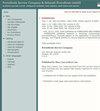Establishment of hybridoma cell lines producing monoclonal antibodies against hepatitis B virus surface antigens (a, d, and r) and development of sensitive ELISA diagnostic test.
引用次数: 6
Abstract
A new treble-coated enzyme-linked immunoadsorbent assay (ELISA) kit of detecting Hepatitis B virus (HBV) surface antigen subtypes a, d and r (HBsAg-a, -d, -r) was developed by using four established hybridoma cell lines, of which two specifically secrete monoclonal antibodies (MAbs) against HBsAg-a (anti-HBsAg-a), one against -d (anti-HBsAg-d), and one against -r (anti-HBsAg-r). The approach of hybridoma cell lines' establishment were by fusing myeloma cells (SP2/0) with splenocytes from BALB/c mice immunized with a mixture of HBsAg-a, -d, -r. The ascitic MAb productivity of the four cell lines was at the titres of 1:10(6)-1:10(8). A treble-coated ELISA based HBV diagnostic kit was developed for detecting all of the three responding subtypes of HBsAgs. A 96-well ELISA microplate was coated with anti-HBSAg-a, -d, -r at a ratio of 3: 1: 0.5, with a horseradish peroxidase (HRP) conjugated anti-HBsAg-a as the labelled antibody. For clinical application, the new developed diagnostic kit detected HBsAgs of adr, adw, ayr, and ayw at a rate of lower than 0.25, 0.25, 0.5, and 0.5 ng/mL, respectively. Results indicated that this kit was more rapid and sensitive than that other current ELISA-based kits coated with a single MAb (e.g., anti-HBsAg-a).产生乙型肝炎病毒表面抗原(a、d、r)单克隆抗体的杂交瘤细胞系的建立及ELISA敏感诊断试验的研制
利用已建立的4株杂杂瘤细胞株,其中2株特异性分泌针对HBsAg-a(抗HBsAg-a)、1株特异性分泌针对-d(抗hbsag -d)和1株特异性分泌针对-r(抗hbsag -r)的单克隆抗体(mab),建立了检测乙型肝炎病毒(HBV)表面抗原亚型A、d和r(抗hbsag -r)的新型三包被酶联免疫吸附测定试剂盒。建立杂交瘤细胞系的方法是用HBsAg-a, -d, -r混合免疫BALB/c小鼠脾细胞融合骨髓瘤细胞(SP2/0)。4个细胞系的腹水单抗产率为1:10(6)~ 1:10(8)。开发了一种基于三层包被ELISA的HBV诊断试剂盒,用于检测所有三种应答型hbsag。以辣根过氧化物酶(HRP)偶联的抗hbsag - A为标记抗体,按3:1:1 .5的比例包被96孔ELISA微孔板。临床应用方面,新开发的诊断试剂盒对adr、adw、ayr、ayw的hbsag检测率分别低于0.25、0.25、0.5、0.5 ng/mL。结果表明,该试剂盒比目前其他单抗包被elisa试剂盒(如抗hbsag -a)更快、更敏感。
本文章由计算机程序翻译,如有差异,请以英文原文为准。
求助全文
约1分钟内获得全文
求助全文

 求助内容:
求助内容: 应助结果提醒方式:
应助结果提醒方式:


